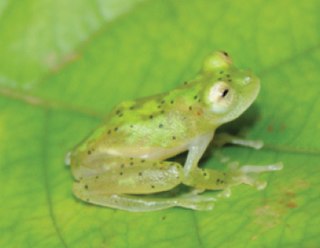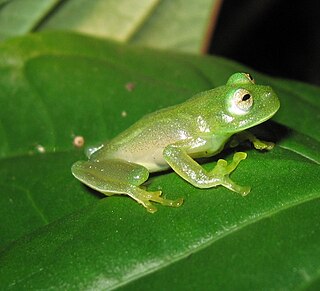
The glass frogs are frogs of the amphibian family Centrolenidae. While the general background coloration of most glass frogs is primarily lime green, the abdominal skin of some members of this family is transparent and translucent. The internal viscera, including the heart, liver, and gastrointestinal tract, are visible through the skin, hence the common name is given as glass frog. Glass frogs are arboreal, meaning they mainly live in trees, and only come out for mating season.

Hyalinobatrachium is a genus of glass frogs, family Centrolenidae. They are widely distributed in the Americas, from tropical Mexico to southeastern Brazil and Argentina.
"Centrolene" medemi is a species of frog in the family Centrolenidae. The species occurs in the Cordillera Oriental in the Tolima, Caquetá, and Putumayo Departments in Colombia and adjacent Napo in Ecuador. The generic placement of this species within the subfamily Centroleninae is uncertain. The specific name medemi honors Fred Medem, collector of the holotype. Common name Medem giant glass frog has been coined for it.
Centrolene notosticta is a species of frog in the family Centrolenidae. It is found on the Cordillera Oriental in Colombia and on its extension to north, Serranía del Perijá, in the Zulia state in Venezuela.
Nymphargus chancas is a species of frog in the family Centrolenidae. Until recently it was only known from its type locality in the Lamas Province in Peru; however, it is now known to occur more widely in the northern San Martín Region of Peru, extending into the Cordillera del Cóndor in Zamora-Chinchipe Province, Ecuador.
"Cochranella" duidaeana, commonly known as the Duida Cochran frog, is a species of frog in the family Centrolenidae. It is endemic to Cerro Duida, Venezuela. The generic placement of this species within the subfamily Centroleninae is uncertain.

Sachatamia orejuela is a species of frog in the family Centrolenidae. It is found on the Pacific versant of the Cordillera Occidental in southern Colombia and on the Pacific Andean slopes of northwestern Ecuador. Common name El Tambo Cochran frog has been coined for it.
Vitreorana ritae is a species of frog in the glassfrog family (Centrolenidae). It is found in Amazonian Brazil, Colombia, Ecuador, and Peru, and in southern Guyana, eastern Surinam, and French Guiana. Its natural habitats are tropical moist lowland forests and rivers. It is threatened by habitat loss.
"Cochranella" riveroi is a species of frog in the family Centrolenidae. It is endemic to Cerro Aracamuni, Venezuela. The generic placement of this species within the subfamily Centroleninae is uncertain.
Cochranella vozmedianoi is a species of frog in the family Centrolenidae, endemic to the Cerro El Humo, in the Paria Peninsula in northern Venezuela.
Vitreorana antisthenesi is a species of frog in the family Centrolenidae. It is endemic to northern Venezuela and is known from the Venezuelan Coastal Range. Common name Aragua glass frog has been coined for it.
Vitreorana helenae is a species of frog in the family Centrolenidae. Two common names are sometimes used to refer to this species: Venezuelan glass frog and Helena's glass frog. In Spanish, it is locally known as ranita de cristal de Helena.

Hyalinobatrachium iaspidiense is a species of frog in the family Centrolenidae from South America. Its specific name refers Quebrada de Jaspe, its type locality.
Hyalinobatrachium orientale is a species of glass frog in the family Centrolenidae. It is found on the island of Tobago and in eastern Venezuela. Its common name is eastern glass frog. The Tobagonian population has been described as subspecies Hyalinobatrachium orientalis tobagoensis(Hardy, 1984). The latter is sometimes referred to as Tobago glass frog. H. orientale is distributed throughout the Central Eastern ranges of the Cordillera de la Costa in Venezuela and Tobago Island with an altitudinal range of 190 to 1200 meters.

Hyalinobatrachium pellucidum, also known as the Rio Azuela glass frog, is a species of frog in the family Centrolenidae. It is found in lower montane rainforests on the Amazonian Andean slopes in Ecuador and Peru. The specific name pellucidum is Latin for "transparent" and refers to the transparent parietal peritoneum of this species.

Scinax castroviejoi is a species of frog in the family Hylidae. It is found in valleys of the Eastern Andes in southern Bolivia, and controversially, in Argentina. Its type locality is Laguna de Bermejo. It is similar to Scinax fuscovarius but differs in call characteristics. The specific name castroviejoi honors Javier Castroviejo Bolívar, a Spanish zoologist.
Dischidodactylus colonnelloi is a species of frog in the family Craugastoridae. It is endemic to Venezuela and only know from its type locality, Cerro Marahuaca, in the Amazonas State. The holotype was collected by G. Colonnello, hence the specific name colonnelloi.

Vitreorana is a genus of glass frogs that are native to South America, from the Atlantic Forest of Brazil and Argentina to the Amazon rainforest of Colombia and Ecuador and to the Venezuelan Coastal Range and the Guianas.
Celsiella is a small genus of glass frogs endemic to Venezuela. It was established in 2009 and named in honour of Josefa Celsa Señaris, nicknamed "Celsi", a Venezuelan herpetologist who had worked with glass frogs.

Josefa Celsa Señaris is a Venezuelan herpetologist. She has published information about frogs and she has identified new genera and species. Señaris is the director of the La Salle Foundation's Natural History Museum in Caracas.








